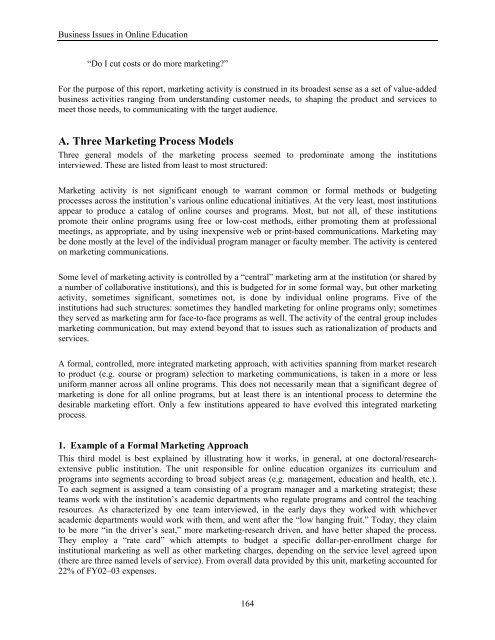Elements of Quality Online Education cation
Elements of Quality Online Education cation
Elements of Quality Online Education cation
You also want an ePaper? Increase the reach of your titles
YUMPU automatically turns print PDFs into web optimized ePapers that Google loves.
Business Issues in <strong>Online</strong> <strong>Edu<strong>cation</strong></strong>“Do I cut costs or do more marketing?”For the purpose <strong>of</strong> this report, marketing activity is construed in its broadest sense as a set <strong>of</strong> value-addedbusiness activities ranging from understanding customer needs, to shaping the product and services tomeet those needs, to communicating with the target audience.A. Three Marketing Process ModelsThree general models <strong>of</strong> the marketing process seemed to predominate among the institutionsinterviewed. These are listed from least to most structured:Marketing activity is not significant enough to warrant common or formal methods or budgetingprocesses across the institution’s various online edu<strong>cation</strong>al initiatives. At the very least, most institutionsappear to produce a catalog <strong>of</strong> online courses and programs. Most, but not all, <strong>of</strong> these institutionspromote their online programs using free or low-cost methods, either promoting them at pr<strong>of</strong>essionalmeetings, as appropriate, and by using inexpensive web or print-based communi<strong>cation</strong>s. Marketing maybe done mostly at the level <strong>of</strong> the individual program manager or faculty member. The activity is centeredon marketing communi<strong>cation</strong>s.Some level <strong>of</strong> marketing activity is controlled by a “central” marketing arm at the institution (or shared bya number <strong>of</strong> collaborative institutions), and this is budgeted for in some formal way, but other marketingactivity, sometimes significant, sometimes not, is done by individual online programs. Five <strong>of</strong> theinstitutions had such structures: sometimes they handled marketing for online programs only; sometimesthey served as marketing arm for face-to-face programs as well. The activity <strong>of</strong> the central group includesmarketing communi<strong>cation</strong>, but may extend beyond that to issues such as rationalization <strong>of</strong> products andservices.A formal, controlled, more integrated marketing approach, with activities spanning from market researchto product (e.g. course or program) selection to marketing communi<strong>cation</strong>s, is taken in a more or lessuniform manner across all online programs. This does not necessarily mean that a significant degree <strong>of</strong>marketing is done for all online programs, but at least there is an intentional process to determine thedesirable marketing effort. Only a few institutions appeared to have evolved this integrated marketingprocess.1. Example <strong>of</strong> a Formal Marketing ApproachThis third model is best explained by illustrating how it works, in general, at one doctoral/researchextensivepublic institution. The unit responsible for online edu<strong>cation</strong> organizes its curriculum andprograms into segments according to broad subject areas (e.g. management, edu<strong>cation</strong> and health, etc.).To each segment is assigned a team consisting <strong>of</strong> a program manager and a marketing strategist; theseteams work with the institution’s academic departments who regulate programs and control the teachingresources. As characterized by one team interviewed, in the early days they worked with whicheveracademic departments would work with them, and went after the “low hanging fruit.” Today, they claimto be more “in the driver’s seat,” more marketing-research driven, and have better shaped the process.They employ a “rate card” which attempts to budget a specific dollar-per-enrollment charge forinstitutional marketing as well as other marketing charges, depending on the service level agreed upon(there are three named levels <strong>of</strong> service). From overall data provided by this unit, marketing accounted for22% <strong>of</strong> FY02–03 expenses.164
















